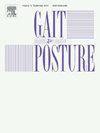Effects of arm movement on emotional state and walking outcomes during height-induced postural threat in healthy young adults
IF 2.2
3区 医学
Q3 NEUROSCIENCES
引用次数: 0
Abstract
Background
There is evidence that height-induced postural threat leads to detrimental effects on walking performance. However, little is known about how the additional restriction of stabilizing arm movements affects gait and emotional state outcomes.
Objective
The purpose was to investigate how the restriction of arm movement affects subjective and objective balance-related measures during walking at or above ground-level.
Methods
Twenty-two healthy young adults (11 males, 11 females; mean ± SD age; 24.4 ± 4.9 years) walked five meters at self-selected speed on ground-level (no threat) and 80 cm above ground-level (threat) with free and restricted arm movement. Emotional state outcomes were quantified by assessing self-reported balance confidence, fear of falling, perceived instability, and conscious balance processing. Walking outcomes (i.e., gait velocity, cadence, step time, normal impulse) were calculated using pressure-detecting insoles.
Results
Irrespective of arm movement condition, height-induced postural threat evoked a decrease in balance confidence and increases in fear of falling, perceived instability, and conscious balance processing as well as deteriorations in walking outcomes (i.e., decrease in gait speed and cadence; increase in step time and normal impulse). For balance confidence and step time, the threat-induced impairments were further amplified when arm movements were restricted.
Conclusions
The strengthening of the height-induced deteriorations in emotional state (balance confidence) and walking (step time) outcomes due to the restriction of the arm movements emphasizes the importance of stabilizing, free arm movements (‘upper body strategy’) for dynamic postural control.
手臂运动对健康年轻人在高度诱导的姿势威胁中情绪状态和行走结果的影响
有证据表明,高度引起的姿势威胁会对行走性能产生不利影响。然而,对稳定手臂运动的额外限制如何影响步态和情绪状态结果知之甚少。目的探讨在地面或地面以上行走时,手臂活动受限对主观和客观平衡相关措施的影响。方法健康青壮年22例(男11例,女11例;平均± SD年龄;24.4 ± 4.9岁)在地面(无威胁)和距离地面80 cm(有威胁)上以自行选择的速度行走5米,手臂活动自由且受限制。情绪状态结果通过评估自我报告的平衡信心、对跌倒的恐惧、感知的不稳定性和有意识的平衡处理来量化。使用压力检测鞋垫计算步行结果(即步态速度,节奏,步数,正常冲量)。结果在不同的手臂运动条件下,高度引起的姿势威胁引起平衡自信下降,跌倒恐惧增加,感知不稳定和有意识的平衡处理,以及步行结果的恶化(即步态速度和节奏下降;增加步长时间和正常脉冲)。对于平衡信心和步长,当手臂运动受到限制时,威胁引起的损伤进一步放大。结论:由于手臂运动的限制,高度引起的情绪状态(平衡信心)和行走(步数)结果的恶化,强调了稳定、自由的手臂运动(“上半身策略”)对动态姿势控制的重要性。
本文章由计算机程序翻译,如有差异,请以英文原文为准。
求助全文
约1分钟内获得全文
求助全文
来源期刊

Gait & posture
医学-神经科学
CiteScore
4.70
自引率
12.50%
发文量
616
审稿时长
6 months
期刊介绍:
Gait & Posture is a vehicle for the publication of up-to-date basic and clinical research on all aspects of locomotion and balance.
The topics covered include: Techniques for the measurement of gait and posture, and the standardization of results presentation; Studies of normal and pathological gait; Treatment of gait and postural abnormalities; Biomechanical and theoretical approaches to gait and posture; Mathematical models of joint and muscle mechanics; Neurological and musculoskeletal function in gait and posture; The evolution of upright posture and bipedal locomotion; Adaptations of carrying loads, walking on uneven surfaces, climbing stairs etc; spinal biomechanics only if they are directly related to gait and/or posture and are of general interest to our readers; The effect of aging and development on gait and posture; Psychological and cultural aspects of gait; Patient education.
 求助内容:
求助内容: 应助结果提醒方式:
应助结果提醒方式:


